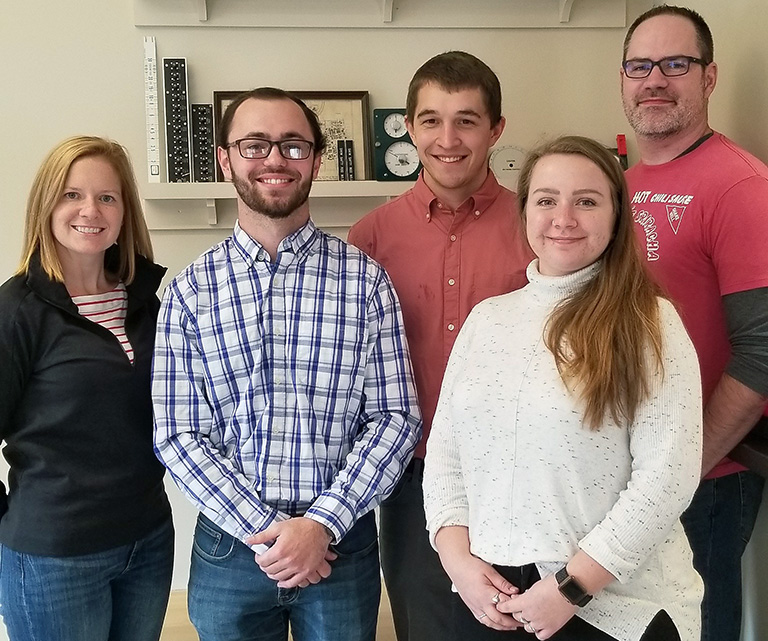
From left to right: Diane Ezell, PhD, R&D Associate in the Nuclear Experiments and Irradiation Testing Group (NEIT) at ORNL; Miller McSwain; Tyler Steiner; Emily Hutchins; Richard Howard, PhD, irradiation engineer with ORNL and lead INSET researcher.
The best launch window for sending spacecraft to Mars is every 2 years and 2 months, when the planets are at their closest distance. Even then, it takes 150-300 days for a traditional rocket to get to the red planet. However, nuclear thermal propulsion (NTP) research conducted by students in UT’s Nuclear Engineering Department might make it possible for NASA to one day cut down the length of the trip to Mars by half.
Nuclear engineering doctoral students Tyler Steiner and Emily Hutchins, along with Miller McSwain, a junior, recently traveled to the Ohio State University Research Reactor to prove the feasibility of a nuclear rocket engine in a research reactor. One of the challenges posed is that the components necessary to make NTP a reality will need to withstand temperatures reaching more than 2,400 degrees Celsius.
Richard Howard, PhD, is an irradiation engineer with ORNL and the lead researcher on this particular set of experiments called In-Pile Experiment Set Apparatus (INSET). Essentially, INSET is a series of apparatuses designed and built to simulate prototypic conditions seen in an NTP rocket. One of the roles of INSET is to provide a test bed for testing materials and instruments that are of interest to NTP.
Steiner, whose roles in this project have included acquiring all of the components to construct INSET, contributing to the design, and building and testing the apparatus, explains that the conditions they are simulating are the extreme temperatures and the radiation fluence of the system.
Hutchins was impressed by the full tour of the building and being able to watch the operator’s process of taking the reactor critical—including getting to see the blue glow of the Cherenkov radiation from the core.
—Emily Hutchins
As an undergraduate student, McSwain counts himself lucky to have the opportunity to participate in experimental research of this caliber. He says he has always had an interest in space travel, so when he was presented with the opportunity to perform NTP research, he jumped at the opportunity.
“Although I was primarily observing the experiment at OSU, seeing the process of setting it up, turning on the reactor, and recording data in a real environment, rather than a hypothetical one, made for a great introduction to experimental research that will aid me in performing more experiments to advance space exploration,” he said.
John D. Tickle Professor Lawrence Heilbronn, faculty mentor for the students, couldn’t make the trip to OSU this time, but looks forward to participating in future runs there.
“I’m fortunate to be associated with Dr. Howard’s research program and am grateful for the opportunity it gives to my students. Tyler, Emily, and Miller are essential to the success of the program and have done a great job,” Heilbronn said.
The team is looking forward to reporting on their results at the upcoming NETS2020 conference to be held April 6-9, 2020, in Knoxville, and to performing more experiments at OSU in the coming year.